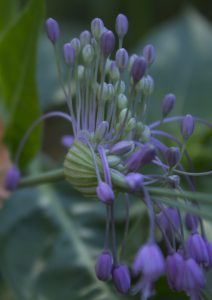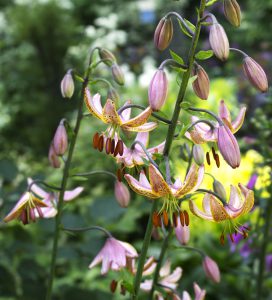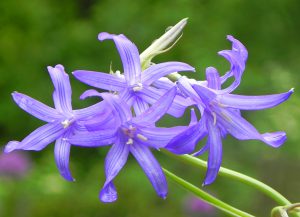Tulips and daffodils pop to the top of the mind in fall when bulb-planting season rolls around. But there are so many more bulbs that wait until June, or even July to unfurl their colorful blooms. And you should plant these all at the same time as the spring-bloomers. Here is a list of six summery candidates you should plant in fall:
Allium:

Allium carinatum surprises gardeners by blooming in July.
We know, and possibly grow, the great, big, Seuss-like big-headed Allium, most of which bloom along with the peonies. But there are several, more subtle Allium species that offer a whole new look in June and July.
- Allium bulgaricum: Picture a fairy wand for muscular sprites. Its stems are long (around 20”), and end in a tuft of straight-up buds that gradually lengthen, droop, and open into dozens of delicate bells, which are striped with cream, green and rose. This Mediterranean native is no longer considered an allium, and is now called Nectaroscordum siculum subsp. Bulgaricum. Either way, it’s an easy plant to tuck in among other late May bloomers. Grows from 32″ to 36″; USDA Hardiness Zones: 6 (or colder) -10
- Allium caeruleum (azureum): This is one flower that comes as close to true blue as a bloom can get. More relaxed in attitude than the big-headed Allium, A caeruleum sports individual florets that form a circle about the size of a golf ball. The hardest part about growing this blue beauty is leaving its slender stems alone when they seem to come out of nowhere in early May. Grows up to 18” high; USDA Hardiness Zones 4-7.
- Allium carinatum ssp. Pulchellum: Practice saying this one’s name, because anyone who sees it blooming will want to know what it is. The most common description given is that it looks like purplish-pink fireworks. Appearing almost overnight on 18” stems, this European species increases easily enough that you’ll have plenty to share with admirers. Blooming in mid-July; USDA hardiness Zones 5-8.
- Allium moly: An unusual color in the world of Allium, A. moly earns a second glance with its bright yellow flowers. At just a foot tall and hovering above blue-green leaves, this is an easy mixer with the shorter, early-June stars of the garden. Hardiness Zones 3-8.
Dichelostemma:
Dichelostemma is a genus with five species including distributed throughout the western United States, especially in northern California. According to the Pacific Bulb Society, D. congestum, which is commonly known as forktooth ookow or congested snake lily, is found in meadows and open woods from central California extending north of California into Canada. It blooms from April to June carrying dense, many-flowered clusters. In Arizona desserts, it blooms along with California poppy, often as early as March.
The good news for those in colder climates is that it’s hardy enough for the Midwest. Planted in clusters of at least a dozen, these 20” tall violet beauties will look great along with other early June bloomers.
Eremurus:
Foxtail lily is the common name for these stately flowers, but they have nothing to do with lilies. They’re one of the most exotic-looking bulbs of summer, emerging like rockets reaching up to four feet tall before unfurling each individual yellow, white, pink or orange floret from bottom to top.
It’s good to plant these brittle, star-shaped roots as soon as they arrive in the mail. Select the planting spot with care because they don’t like to be moved, and they don’t like overplanting or a lot of digging around them. They shouldn’t be transplanted unless absolutely necessary.
The Chicago Botanic Garden suggests digging a 15-inch wide hole six inches deep in the prepared site, and mounding a shallow cone of soil in the center. To improve drainage, add an inch or two of coarse sand before spreading the roots out over the cone. Cover with 4 to 6 inches of soil. Also called Desert Candles, Eremurus grow from 48” to 60” tall, and are hardy from Zones 6-9 (Zone 5 with two inches of protective mulch after the ground freezes.)
Lilium:

‘Guinea Gold’ is a martagon hybrid that might take two years to bloom. It’s worth the wait.
Examples of Lilium include those found at supermarkets around Easter and Mother’s Day. Some grow well above our heads, while others, like the Lily Looks series, just graze our knees. While there are close to 100 species, most of what is commonly available are hybrids, or crosses of two or more species. It’s a win-win, because the hybrids have been bred for disease resistance and increased vigor. I select most lilies for fragrance, but I also prefer the light colored lilies that seem to glow at dusk. While most of my lilies bloom in July, some start as early as peony season. Depending on which species or hybrid, hardiness of Lilium ranges from Zone 3 to Zone 8, so check each individual variety. Here are several I can recommend for Zones 5 and 6. Months listed indicate when they typically begin to bloom.
- ‘Guinea Gold’ (early – mid June)
- ‘Eyeliner’ (early – late June)
- ‘Red Velvet’ (early – mid July)
- ‘Conca d’Or’ (early – mid July)
- ‘Orania’ (early – mid-July)
- ‘Porcelain Doll’ (early – mid-July)
Ixiolirion

A close-up of the flower cluster of Ixiolirion.
If plants were as difficult to grow as their names are to pronounce, gardens certainly would be limited. Ixiolirion tataricum ssp pallasii has a couple of common names, including Siberian Lily or Tartar Lily, and is native to the steppes of Asia minor, Afghanistan and Syria. It’s incredibly hardy if planted in a sunny, well-drained spot, makes a great companion to peonies, and lasts several days as a cut flower.
Plant Ixiolirion (pronounced ICKS–e– o– LEER–eon) in groups, because each plant is rather wispy. Each individual stem reaches about 18” tall and is topped with a cluster of lavender blooms. It stands up without support, especially if planted in a sunny spot.
Ixiolirion are short-lived, meaning they will thrive in a good location in Zone 6 or colder for a few years before petering out. Mine lasted five years, but they are inexpensive to purchase. You can purchase them at John Scheepers in Bantam, CT.
Ornithogalum
Another tongue-twisting name for an easy-to-grow bulb, Ornithogalum (or-nih-THOG-uh -um) consists of several species. I grow and can recommend one of the many species. Currently, the U.S. has not reported it as invasive. Several years ago I told another gardener I had planted Ornithogalum. Before I could mention which one, she reprimanded me for even considering such an invasive plant. Ornithogalum umbellatum is the species she was thinking of, often popping vigorously up out of nowhere, usually in the lawn, looking pretty for about a week when it offers pretty white flowers. Some plant catalogs and websites offer this plant.
Ornithogalum magnum (giant starflower) is a species I can recommend to anyone from beginning to experienced gardeners. In mid to late May, their stems emerge like asparagus (to which it’s related) and turn into white wands with individual florets opening from the bottom up. It’s 24” – 36” tall, and I’ve never had to stake it. It makes a great cut flower, increases slowly, needing division after about four years. The only “problem” I’ve had with my Ornithogalum magnum was during a drought and roving bands of raccoons dug some of them up.
Recommended with Caution*:
Ornithogalum nutans (silver bells) have come and gone from my garden in a random fashion, and it’s probably because I haven’t found the right place for them. According to the John Scheepers website, it’s not very hardy (to Zone 6) and should be covered with two inches of mulch after the soil freezes. I’m not ready to give up, because these silvery flowers on sturdy, 12”-15” stems make great cut flowers and will brighten up any somewhat shady space. 3-12, silver, green and white flowers blooming alternately towards the top of 12″-15″.
*Although I’ve had trouble getting this species to grow, reports from various areas of the country state that they are invasive. If you would like to try them anyway, watch them for that tendency in your garden.








